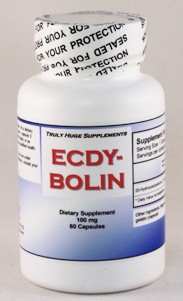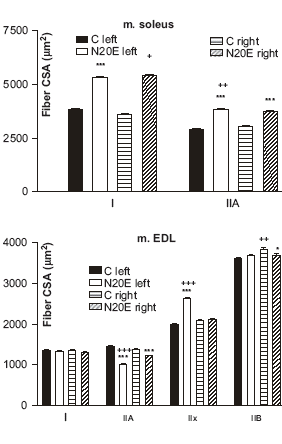
Click Here for Free Bodybuilding and Fitness Magazine Subscription
Ecdysterone Muscle Hypertrophy

Click Here For The Best Ecdysterone Supplement
Ecdysterone Gives Rat Mega-Muscles
It looks more and more certain that ecdysteroids have an anabolic effect. The most recent study on the muscle strengthening effect of insect steroids will appear shortly in Phytomedicine. Researchers from the university of Szeged in Hungary write in the article that rats given ecdysteroids develop thicker muscle fibres.
It looks more and more certain that ecdysteroids have an anabolic effect. The most recent study on the muscle strengthening effect of insect steroids will appear shortly in Phytomedicine. Researchers from the university of Szeged in Hungary write in the article that rats given ecdysteroids develop thicker muscle fibres.
Ecdysteroids are the hormones insects use for moulting and cocooning. About five percent of the plant world also manufactures these same substances as a biological weapon against insect pests. If insects eat these plants they start to cocoon - so they stop eating the plant. Problem solved.

|
In the days of the Iron Curtain, many studies appeared in Eastern Bloc countries on the anabolic effect of ecdysteroids in animals. As a result of these the supplements industry promptly came up with plant hormones and put them on the market. Mesobolin for example contains turkesterone, an anabolic ecdysteroid, and Testabolan contains 20-hydroxy-ecdysterone, the substance that the Hungarian researchers tested. For a long time it was not clear whether ecdysteroids really work. Eastern Bloc scientists sometimes reported results that later turned out to have been pulled out of a hat, often because Big Brother State had applied pressure to produce results.
But recent studies suggest that ecdysteroids really do work. American researchers published the results of a study a few months ago, in which rats got bigger muscle cells and became stronger after receiving 20-hydroxy-ecdysterone and turkesterone. [J Agric Food Chem. 2008 May 28;56(10):3532-7.]
The research done at the university of Szeged is also an animal study. The researchers injected rats for a period of eight days with 5 mg 20-hydroxy-ecdysterone per kg body weight per day. They extracted the plant steroid from Silene viridiflora.
The rats received the injection in their left paw. After the eight days, the researchers examined which muscle fibres had grown. They looked at the soleus, a muscle composed mainly of slow type-1 fibres, and at the extensor digitorum longus, a calf muscle with fast muscle fibres. [EDL below.]

Below you see how the CSA in the muscle fibres changed. Put simply, CSA is a measure for the circumference of the fibres. Type-1 fibres are slow fibres. Type-2 fibres (which come in A, B and X flavours) are fast fibres. People who do power sports use mostly fast fibres.
The ecdysteroid works, the researchers conclude.
The researchers also mention that ecdysteroids have less effect in tests on castrated rats, and more effect on intact animals. The plant steroids therefore strengthen the effect of testosterone, but cannot replace it.
The Hungarian study does not throw light on exactly how ecdysteroids work, but it is becoming clearer that they do work.
Sources:
Phytomedicine. 2008 Sep;15(9):691-8.
J Agric Food Chem. 2008 May 28;56(10):3532-7.

